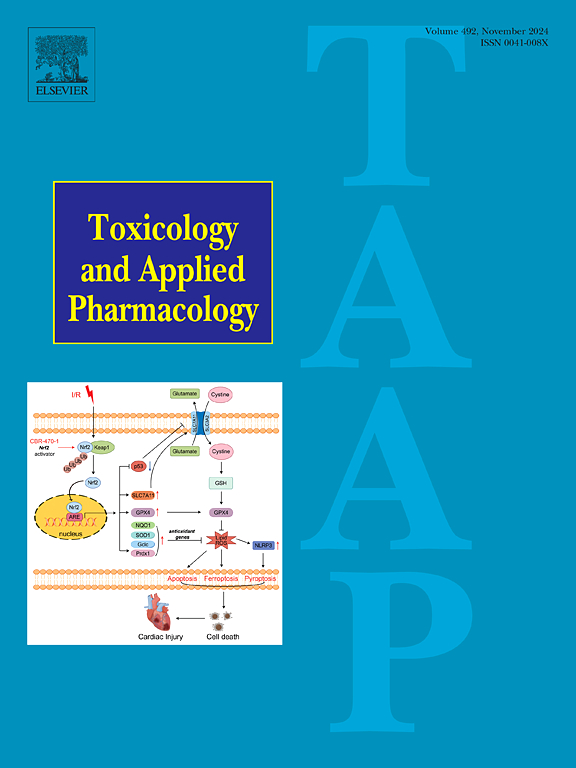白藜芦醇可减轻4-叔辛基酚引起的心脏畸形中活性氧介导的DNA损伤。
IF 3.3
3区 医学
Q2 PHARMACOLOGY & PHARMACY
引用次数: 0
摘要
4-叔辛基酚(4-t-OP)是一种广泛存在于环境中的烷基酚类环境内分泌干扰物,对生物具有潜在危害。研究表明,4-t-OP可诱导心脏损伤和胚胎发育异常,对心脏发育产生不利影响。4-t-OP引发的活性氧(ROS)过量产生可能导致DNA损伤。因此,我们假设ros介导的DNA损伤在暴露于4-t-OP的斑马鱼胚胎心脏异常发育中起着至关重要的作用,而天然食品中常见的抗氧化剂白藜芦醇(RSV)可能提供保护。在本研究中,我们将受精后2 h (hpf)的斑马鱼胚胎暴露于不同剂量的4-t-OP联合相关抑制剂/激动剂治疗。在显微镜下,我们观察到斑马鱼胚胎在72 hpf时心脏结构的形态学改变。通过免疫荧光、DCFH-DA探针、MitoSOX™染色、定量聚合酶链反应等方法评估潜在的分子机制。我们的研究结果显示,4-t-OP引起斑马鱼胚胎的剂量依赖性心脏缺陷。加入RSV或ROS抑制剂n -乙酰- l-半胱氨酸(NAC)可显著降低4-t-OP诱导的ROS/线粒体ROS (mtROS)过表达。此外,RSV或NAC的加入显著减轻了心脏畸形、心脏凋亡和DNA损伤。此外,凋亡抑制剂Ac-DEVD-CHO和Wnt/β-catenin激动剂CHIR99021可降低4-t- op诱导的心脏异常。此外,天然存在的小分子化学RSV对4-t- op诱导的心脏发育损伤具有保护作用。本研究阐明了4-t-OP通过ROS/Wnt/β-catenin信号通路诱导斑马鱼幼体心脏氧化应激、DNA损伤和心脏缺陷的分子机制。这些发现为预防和治疗先天性心脏病提供了新的分子靶点,并增强了我们对4-t-OP心脏毒性作用的理解。本文章由计算机程序翻译,如有差异,请以英文原文为准。
The resveratrol attenuates reactive oxygen species mediated DNA damage in cardiac malformations caused by 4-tert-octylphenol
4-tert-octylphenol (4-t-OP) is an alkylphenolic environmental endocrine disruptor extensively distributed in the environment, posing potential hazards to living organisms. Research has demonstrated that 4-t-OP induces cardiac injury and abnormalities in embryonic development, which can adversely affect heart development. The excessive production of reactive oxygen species (ROS) triggered by 4-t-OP may result in DNA damage. Hence, we hypothesized that ROS-mediated DNA damage plays a crucial role in abnormal cardiac development in zebrafish embryos exposed to 4-t-OP, while resveratrol (RSV), a common antioxidant found in natural foods, may provide protection. In this study, we exposed zebrafish embryos at 2 h post-fertilization (hpf) to various doses of 4-t-OP in combination with relevant inhibitor/agonist therapies. Using microscopy, we observed morphological alterations in the cardiac structure of zebrafish embryos at 72 hpf. The underlying molecular mechanisms were assessed through immunofluorescence, DCFH-DA probe, MitoSOX™ staining, Quantitative polymerase chain reaction, and other methods. Our findings revealed that 4-t-OP caused dose-dependent cardiac defects in zebrafish embryos. The overexpression of ROS/mitochondrial ROS (mtROS) induced by 4-t-OP was significantly reduced by the addition of RSV or the ROS inhibitor N-acetyl-L-cysteine (NAC). Furthermore, the inclusion of RSV or NAC significantly mitigated cardiac deformities, cardiac apoptosis, and DNA damage. Additionally, the apoptosis inhibitor Ac-DEVD-CHO and the Wnt/β-catenin agonist CHIR99021 decreased 4-t-OP-induced cardiac abnormalities. Moreover, the naturally occurring small molecule chemical RSV provided protection against 4-t-OP-induced heart developmental injury. This study elucidates the molecular mechanisms by which 4-t-OP induces oxidative stress, DNA damage, and cardiac defects in the heart of zebrafish larvae through the ROS/Wnt/β-catenin signaling pathway. These findings present novel molecular targets for the prevention and therapy of congenital heart disease, as well as enhance our understanding of the cardiotoxic effects of 4-t-OP.
求助全文
通过发布文献求助,成功后即可免费获取论文全文。
去求助
来源期刊
CiteScore
6.80
自引率
2.60%
发文量
309
审稿时长
32 days
期刊介绍:
Toxicology and Applied Pharmacology publishes original scientific research of relevance to animals or humans pertaining to the action of chemicals, drugs, or chemically-defined natural products.
Regular articles address mechanistic approaches to physiological, pharmacologic, biochemical, cellular, or molecular understanding of toxicologic/pathologic lesions and to methods used to describe these responses. Safety Science articles address outstanding state-of-the-art preclinical and human translational characterization of drug and chemical safety employing cutting-edge science. Highly significant Regulatory Safety Science articles will also be considered in this category. Papers concerned with alternatives to the use of experimental animals are encouraged.
Short articles report on high impact studies of broad interest to readers of TAAP that would benefit from rapid publication. These articles should contain no more than a combined total of four figures and tables. Authors should include in their cover letter the justification for consideration of their manuscript as a short article.

 求助内容:
求助内容: 应助结果提醒方式:
应助结果提醒方式:


